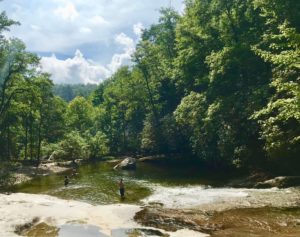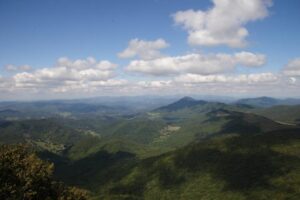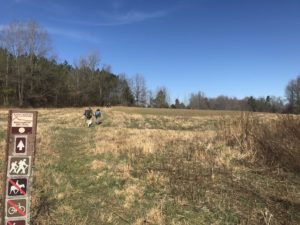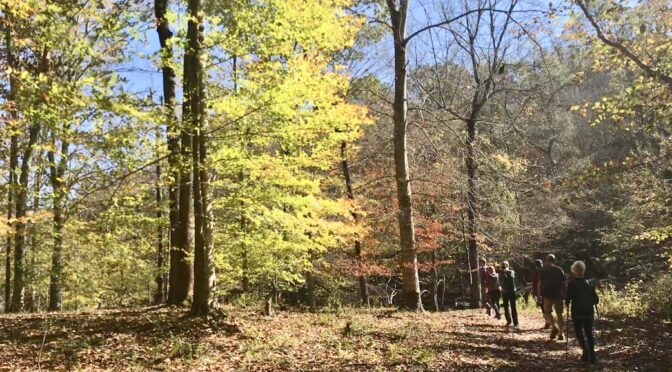Fall, the best time of year to be on the trail, is around the corner. Are you ready?
I don’t mean do you have your gear ready: Rather, do you have your plan of attack in place?
Not to put too much pressure on the fall hiking season, but there is a fair amount of pressure to make the most of the next three months. Sure, spring has its obvious pluses — wildflowers, warming temperatures, rebirth — and winter has its subtle charms. But face it, the combination of a retreat from sweltering temperatures, low humidity, crisp blue skies, and fall color make this the best season to hike in the Southeast.
Thus, it’s important to have a plan to make the most of autumn. Like, where to go first?
Because you can’t be in two or more places at once, you need to plan your hikes accordingly by taking into account the best time to hike a given trail. You still may not be able to hit all your favorites this fall, but with smart scheduling you can hit a goodly number of them.
Here’s how I approach the fall hiking season.
September
We associate the start of fall with the Labor Day weekend, the start of school, the start of football. In reality, though, the calendar says fall doesn’t officially start until Sept. 22, and even then, we can still experience temperatures topping 80 for another month. The point: take advantage of this continuing warm weather by taking two factors into consideration:
-

Gragg Prong, Wilson Creek area Elevation. It will start cooling — but not yet be cold — at higher elevations in September. Take advantage of this early pleasantness by hitting the high country trails you missed in summer. Come mid-October, you’ll begin dealing with true cold above 4,000 to 5,000 feet, and by November, limited access due to snow, ice and seasonal road closings on Forest Service land. Examples: North Carolina’s Black Mountains and the Shining Rock Wilderness; the Mount Rogers area of Virginia.
- Water. If you didn’t get a chance to hike this summer on a trail with multiple stream crossings, waterfalls and pools for lollygagging, you did not have a complete summer. Air and water temps at lower mountain elevations — 3,000 feet and below — will remain warm enough through the month for a summer-like experience. Examples: Wilson Creek in North Carolina; St. Mary’s Wilderness in Virginia.
October

Four factors to keep in mind for your October hikes:
- Fall color. Here’s another misconception: The start of October means immediate fall color. In fact, the fall color change typically doesn’t begin until mid to late October in the Piedmont. Even at the highest elevations, it doesn’t begin until late September. If you’ve got a hankerin’ for early fall color, put the high country on your early October list, and keep an eye on the fall color tracking websites (ExploreAsheville.com, VirginiaisforLovers.org) which track where the color is currently best (depending on temperature, cloud cover and rainfall, the emergence of color can vary wildly). Examples of early fall color: Elk Knob State Park, Mount Jefferson State Natural Area in North Carolina; Mount Pleasant National Scenic Area in Virginia.
- Crowds. Fall, especially October, is the most popular time of year to hike. Folks who otherwise balk at having to park in the outer lot at the mall suddenly channel their inner John Muir and hit the trail. The good news: they generally gravitate to trailheads that have: 1) a Visitor Center, 2) Restrooms, 3) paved parking, 4) an address for the trailhead. Avoid these four traps, especially on idyllic fall weekends, and you should be fine. Examples of off-the-beaten-path trailheads: Pilot Creek and Pinnacle Hotel Road accesses to Pilot Mountain State Park in North Carolina; Osprey Point Access, Smith Mountain Lake State Park in Virginia.
- Temperature. From the beginning of October to the end, you’ll notice significant drops in temperature. Remember to layer.
- Sunset. Likewise, the amount of afternoon sunlight you’ll have diminishes significantly during October. For example, on Oct. 1, sunset in Raleigh is at 6:59:49; on Oct. 31, the sun will set at 6:21:37. Be aware when planning late day hikes.
November

November, especially the first half, is the sweet spot of your fall hiking season. In reality, in the Piedmont fall color is near peak at this time, and the cooler temperatures — too cool for the occasional hiker — make for ideal hiking conditions. There’s a quiet that dominates the woods, and there’s just the slightest hint of the coming transition to winter. Great color, fewer people, perfect weather — now is the time to hit the more popular trails, even on weekends.
Fall is prime hiking season in the Southeast. Make the most of it by planning accordingly.
